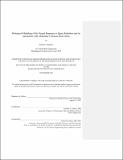Bioastronautics: Biological Modeling of the Neural Response to Space Radiation and its interaction with Alzheimer's Disease Risk Genes
Author(s)
Hinshaw, Robert G
DownloadThesis PDF (10.18Mb)
Advisor
Lemere, Cynthia A.
Terms of use
Metadata
Show full item recordAbstract
The exotic radiation permeating interplanetary space remains the least understood and perhaps most challenging intrinsic barrier to a sustained human presence beyond Earth. As the coming decade brings the promise of continuous lunar habitation and even the first voyage to another planet, spacefaring endeavors must contend with this ever present threat to human health. On Earth, as medical advances continue to extend human life and radiation becomes an increasingly potent tool for medical diagnostics and treatment, we are increasingly confronted by our lack of knowledge on long term health effects and disease interactions of low dose - and in the case of cancer radiotherapy not so low dose - radiation exposure.
93The goal of this dissertation is to explore and develop both new and existing in vitro neural models for radiation research – particularly in the context of neurodegenerative disease. First, we adapt an existing 3D in vitro model of Alzheimer’s disease, which captures the beta-amyloid (Aβ) and phosphorylated tau protein aggregation characteristic of the disease, for use with the particle accelerator facility at the NASA Space Radiation Laboratory (NSRL). We show consistent changes in Alzheimer’s protein pathology and marked differences in RNA transcription dependent on culture genotype and radiation type. Then we expand on that model, leveraging the flexibility of in vitro systems to incorporate a microglial migration assay and to better model the low fluence nature of the space radiation environment while still retaining compatibility with the NSRL accelerator. We then show proof-of-concept for an accelerator-compatible, rapid differentiation neuron astrocyte coculture model derived from human induced pluripotent stem cells in which we investigate the impact of allelic variants in the APOE gene on the interaction between radiation exposure and Alzheimer’s-relevant proteins and RNA transcription. Finally, we explore the development of an ex vivo organotypic brain slice culture model and the challenges to and benefits of adapting such a platform for use with microbeam accelerators.
This work develops approaches to improve both the biological fidelity and the irradiation fidelity of these model systems with the overall goal of creating better tools for investigating the long-term neural consequences of radiation exposure.
Date issued
2022-09Department
Harvard-MIT Program in Health Sciences and TechnologyPublisher
Massachusetts Institute of Technology